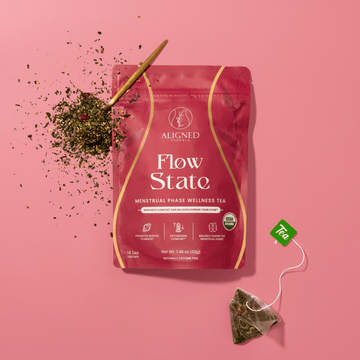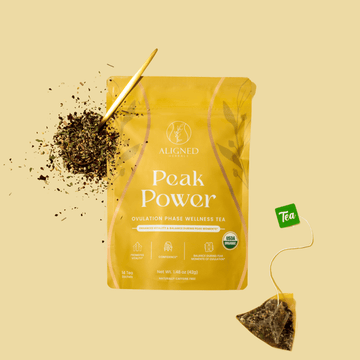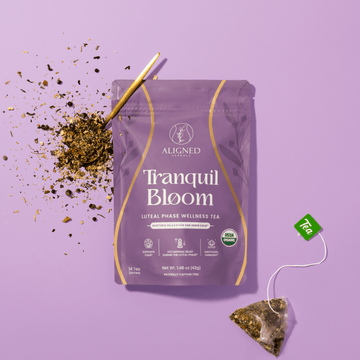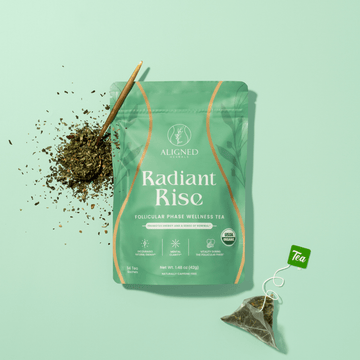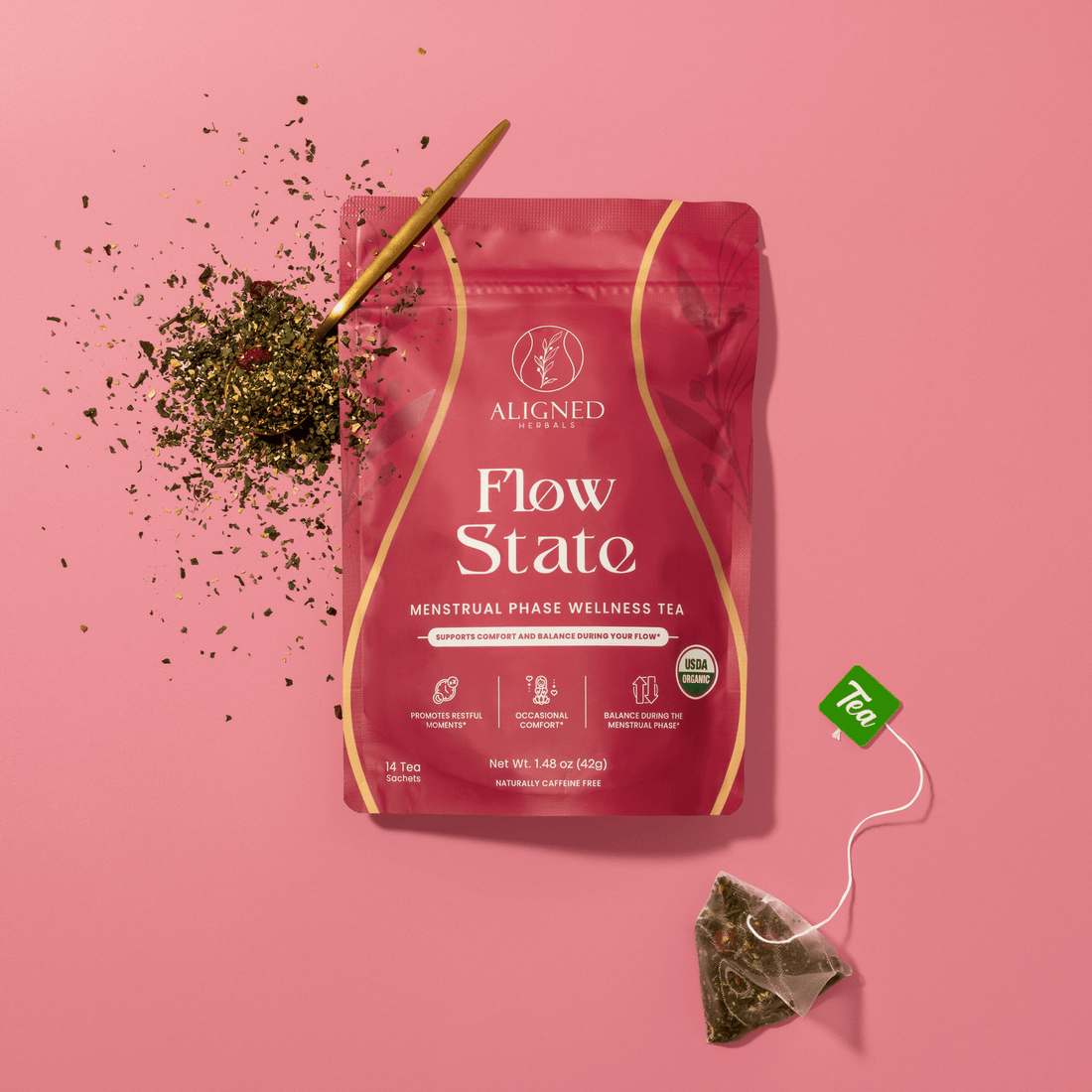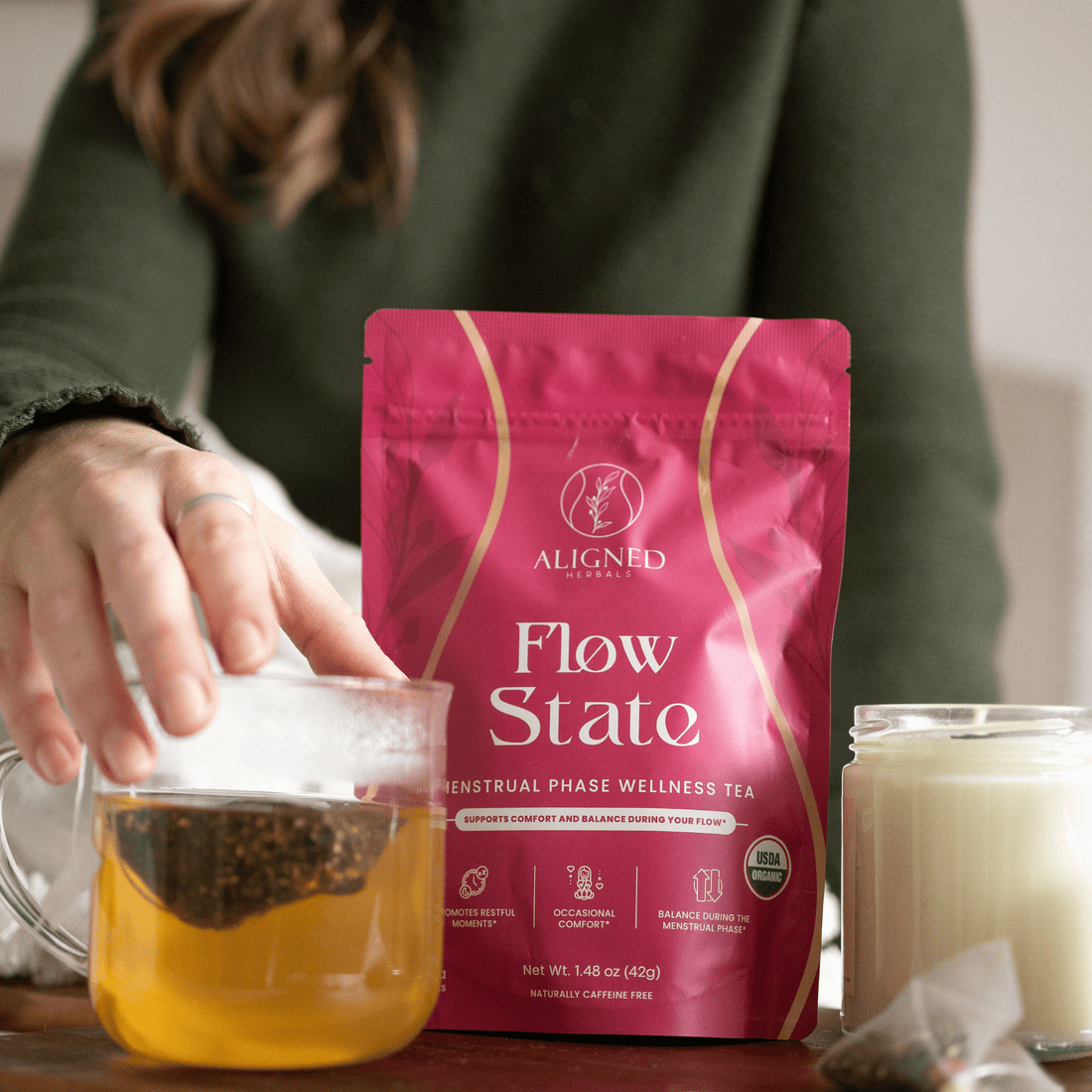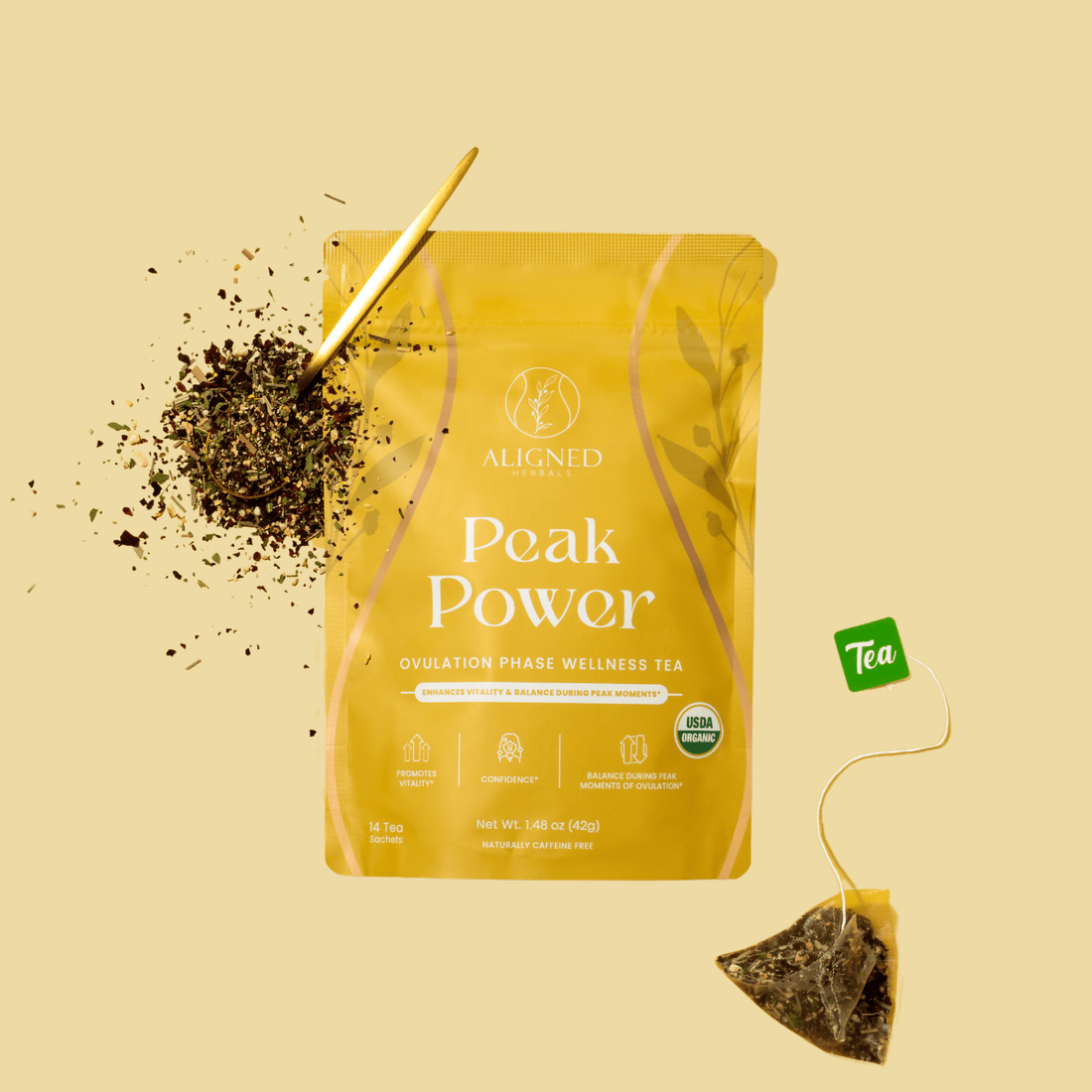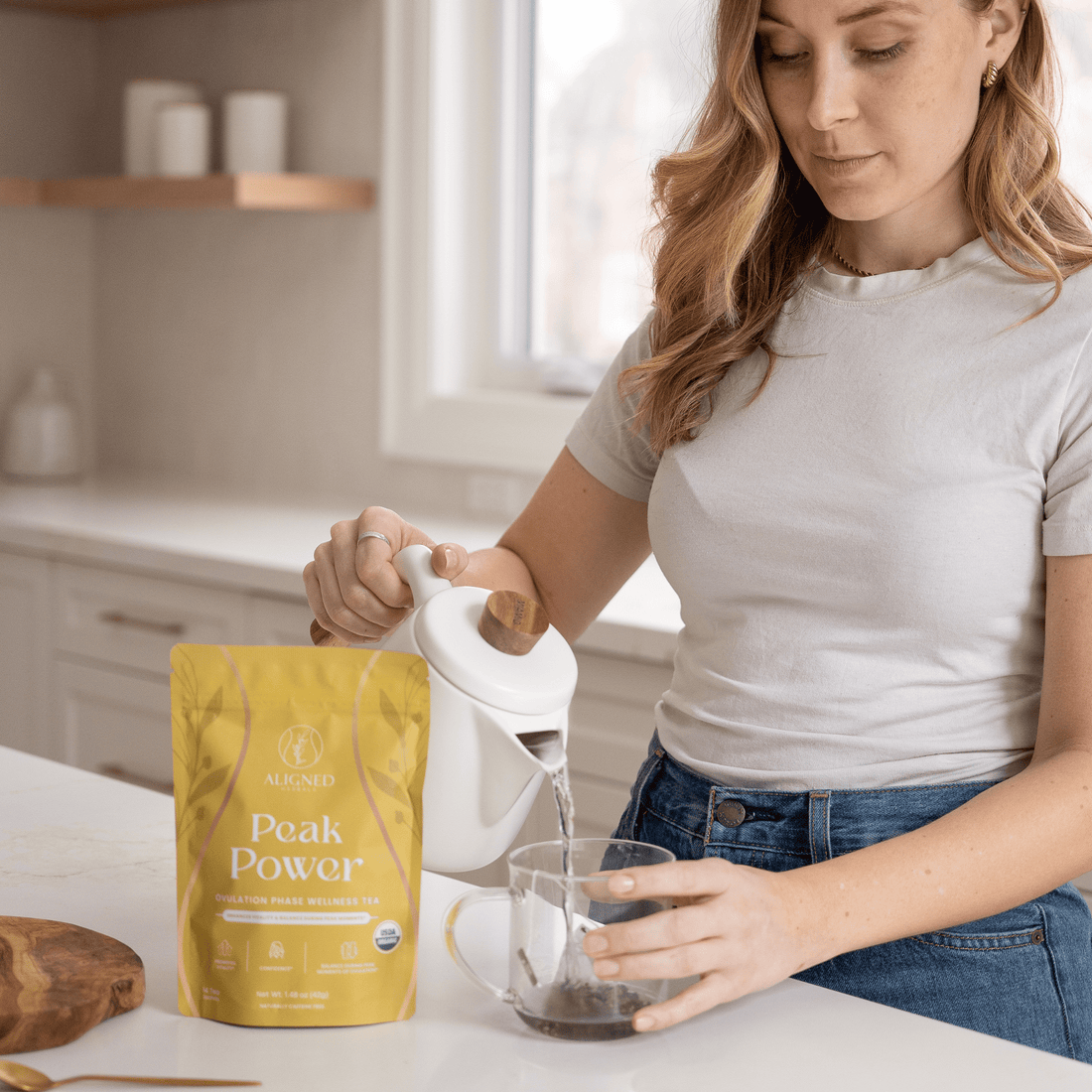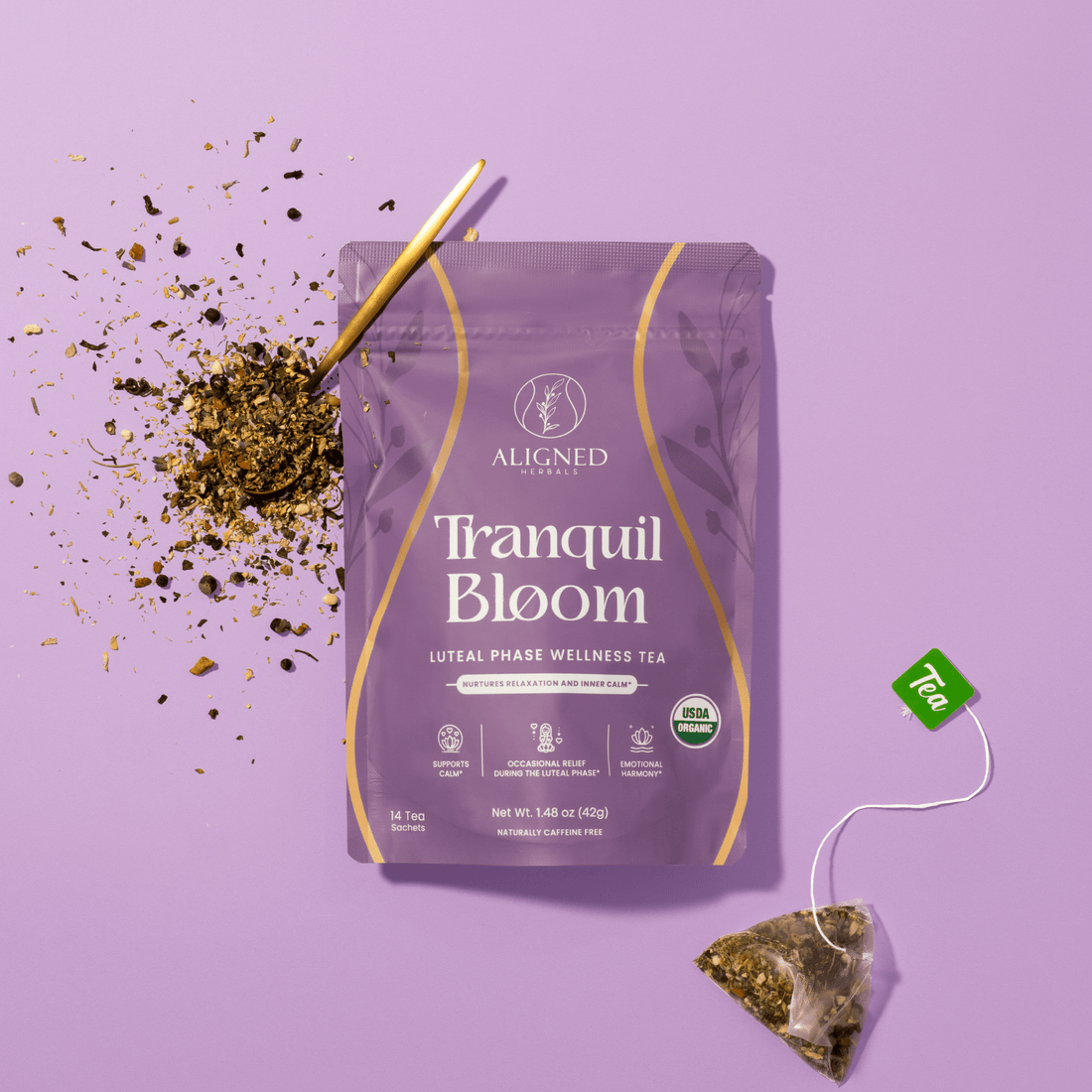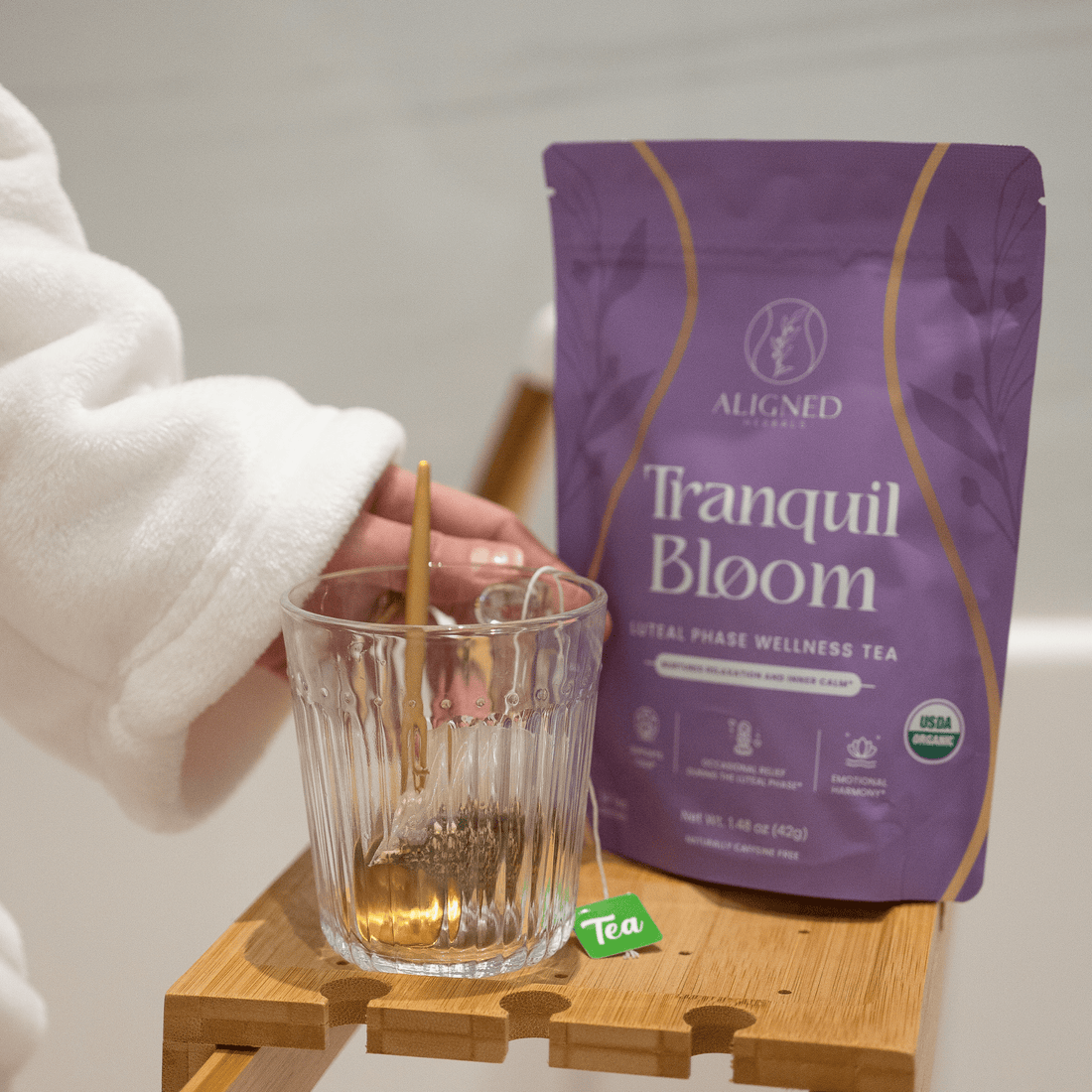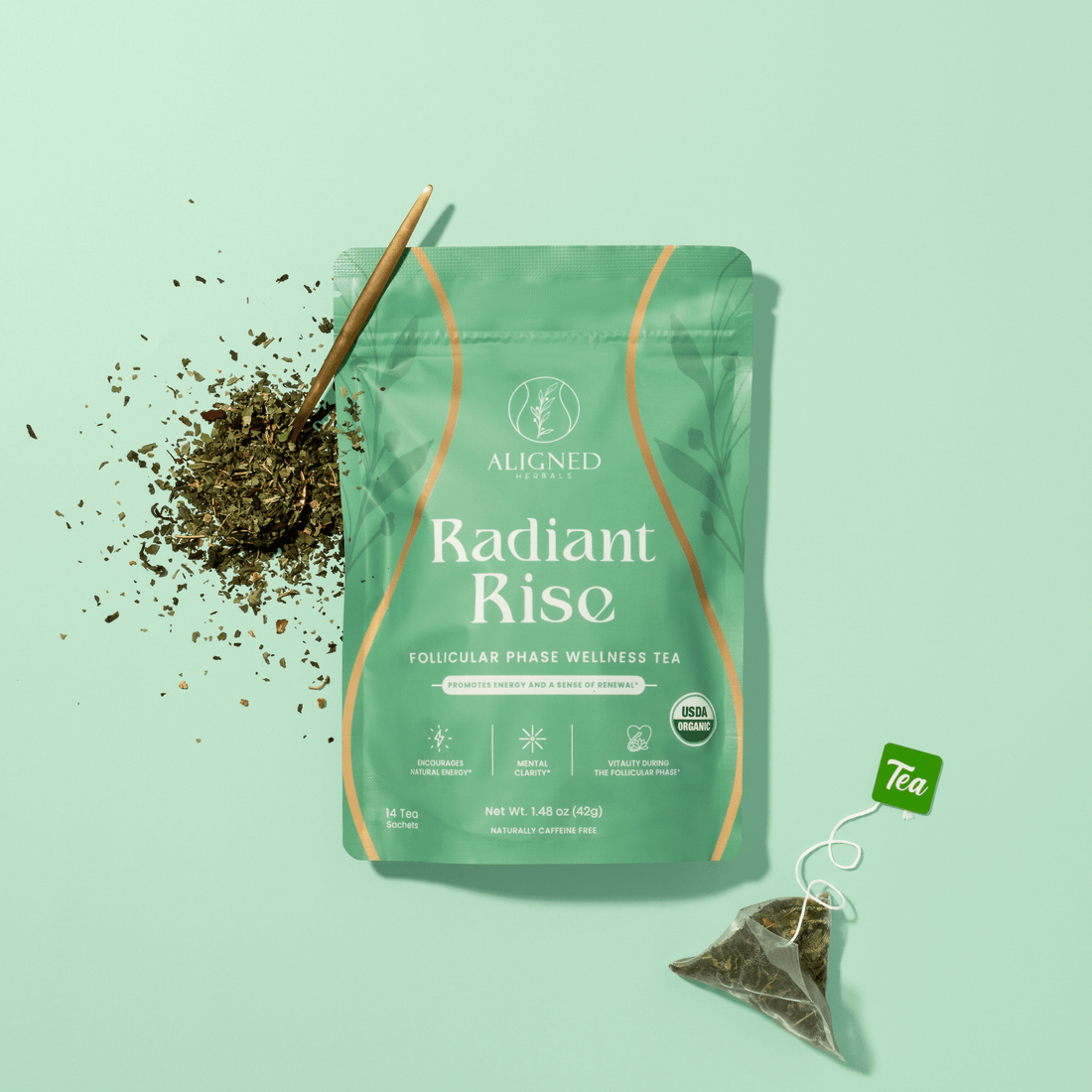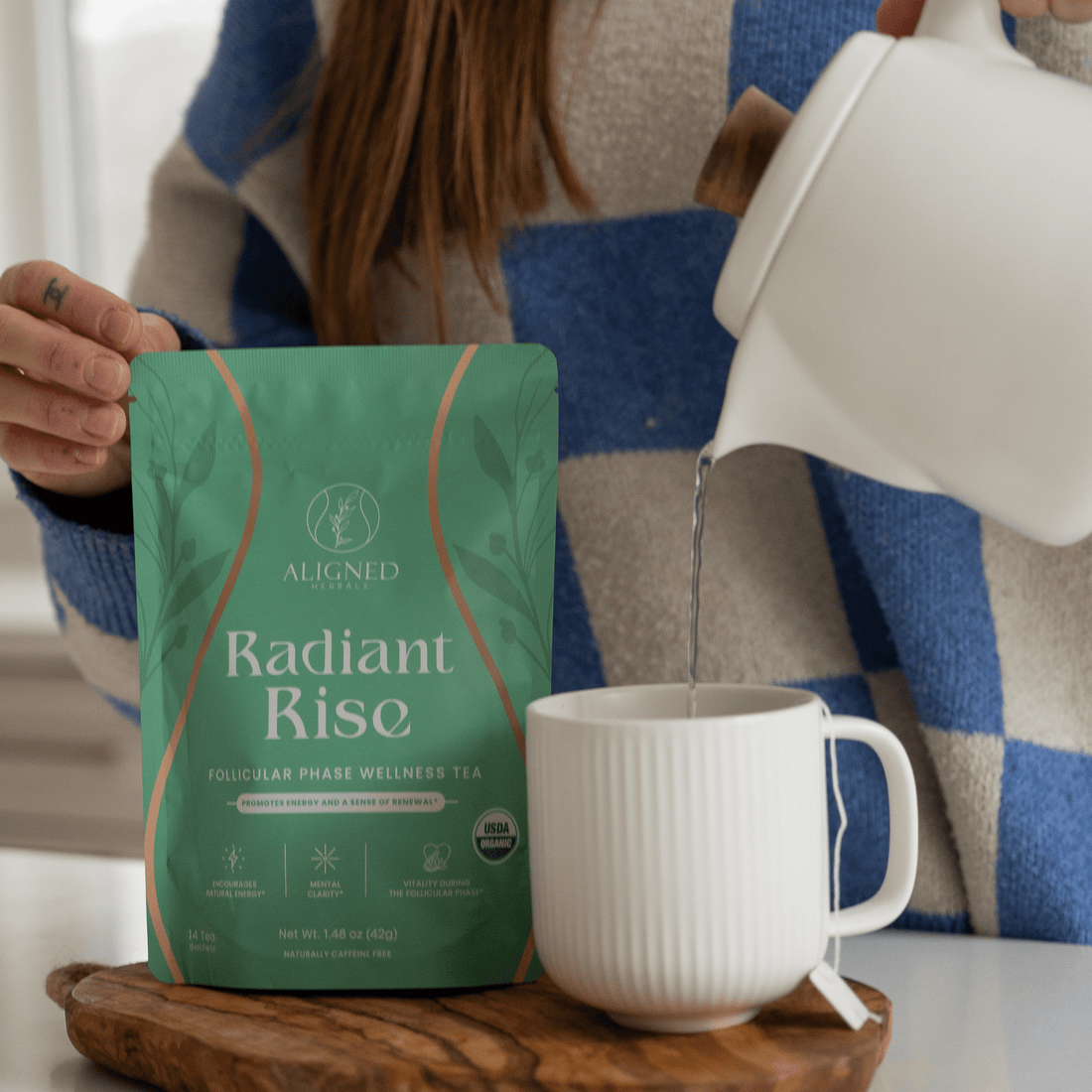Beat the "Luteal Phase Ugly" with Science-Backed Herbal Tea
Understand what's happening hormonally and discover gentle, pregnancy-safe rituals that actually work
At-a-Glance: Luteal Phase "Uglies" + Herbal Tea Fixes
"Luteal phase ugly" is the internet's cheeky shorthand for that late-cycle cocktail of puffiness, breakouts, bloat, and meh-moods. It's not your imagination—hormone swings (hello, progesterone), a small bump in body temperature, and fluid shifts can change how you look and how you feel about how you look. The fix isn't punishment. It's kinder rituals—starting with a warm mug.
What helps (fast):
- Tea ritual > quick hacks: warmth + hydration + soothing botanicals can ease bloat and tension while signaling your nervous system to downshift.
- Pick PMS-friendly herbs: calming (chamomile, lemon balm), digestive (ginger), and balancing blends for the pre-pregnancy window.
- About raspberry leaf before birth: tradition says "uterine support," but research is mixed. Timing and dosage should be personalized with your clinician—many discuss it later in pregnancy rather than early on.
- Safety first if you're TTC/pregnant: some herbs are better suited to pre-pregnancy. When in doubt, press pause and ask your provider.
Educational only; not medical advice. If you're trying to conceive or already pregnant, review herbal use with your healthcare provider—especially blends that include chasteberry or hibiscus.
For women preparing to have a baby • Evidence-aware, compassion-first
The Aligned Herbals Way: Science-Backed, Heart-Led Support
You want a baby—and you want to feel like you on the way there. That's the heartbeat of our work. Around here, we translate complex hormone talk into everyday rituals you can actually enjoy. We call it aligned living: fewer tabs open, more presence, and a kettle that does half the heavy lifting.
Our philosophy (and promise to you)
We're pro-science and pro-self-kindness. The luteal phase can come with swollen rings, surprise chin zits, a jawline that goes a little soft—plus the mental spiral that follows. We won't tell you to "fix yourself." We'll help you build a soothing micro-ritual that supports bloat, skin, and sleep while respecting the nuances of trying to conceive.
What that looks like in real life
- A calming nightly pour: a fragrant, caffeine-free cup that cues your nervous system to exhale.
- Ingredients with intention: botanicals chosen for PMS support in the pre-pregnancy window—reassessed when pregnancy begins.
- Transparent guidance: we'll always say when to pause, when to ask your clinician, and when the research is still catching up.
Why tea—why now
Tea is practical magic. It's hydration, warmth, and tradition in one ceramic hug. For many women, a simple blend can nudge digestion, ease the edge off irritability, and replace doom-scrolling with a kinder bedtime anchor. And because you're future-focused, we zoom out: what you sip should support today's PMS and honor tomorrow's pregnancy.
Our Aligned Herbals team blends evidence-aware formulas with luxuriously simple rituals. Tranquil Bloom—our luteal phase wellness tea—was crafted for pre-pregnancy calm, digestive comfort, and soft-glow support. If conception happens (yay!), we guide you on when to pause and what to sip next, so your ritual stays aligned with your new chapter.
Cycle literacy • Simple science, zero jargon
What's really happening in the luteal phase (simple science)
After ovulation, your body enters the luteal phase—your internal "nesting" window. Progesterone rises, body temperature ticks up a touch, and fluids shift. For some women, that means softer jawlines, surprise breakouts, tight rings, and a mood that oscillates between "I've got this" and "Do I, though?" You're not broken. You're cyclical.
The hormone choreography (days 15–28, give or take)
- Progesterone, the calmer: It peaks mid-luteal, nudging your nervous system toward rest. Side effect: slower digestion → bloat. Silver lining: better sleep—when habits support it.
- Estrogen's encore: Estrogen has a small second rise early-luteal, then tapers. When it dips near your period, skin can look less bouncy and more reactive.
- Thermostat nudge: Basal body temp typically climbs ~0.3–0.5°C post-ovulation. You may flush easier and feel "over" your heavy moisturizer or thick makeup.
- Neurochemistry ripple: Shifts in serotonin and GABA sensitivity can amplify stress perception. Translation: a minor pimple can feel like a headline.
Why you might feel "luteal phase ugly"
| What's happening | What it feels like | Gentle counter-moves |
|---|---|---|
| Fluid shifts; sodium sensitivity | Puffy under-eyes, snug rings | Warm hydration, mineral-rich meals, light movement |
| Sebum & keratinization changes | Chin/jawline breakouts | Non-stripping cleanse, spot salicylic, hands-off |
| Slower GI motility | Bloat, "tight waist" days | Ginger, walks after meals, fiber you tolerate |
| Neuroactive progesterone metabolites | Frayed patience, low sparkle | Lower evening light, breathwork, cozy rituals |
Rituals that work • Gentle, practical, delicious
Tea as a tool: how (and when) it helps
You don't need a 27-step protocol to feel better in the luteal phase. You need a kettle, five quiet minutes, and herbs with a job to do. Tea is warm hydration (great for fluid balance), aromatic therapy as you inhale the steam, and targeted plant chemistry in a soothing format. Simple? Yes. Powerful? Also yes.
The trifecta: warmth, aroma, botanicals
Warmth
Warm liquids encourage gentle circulation and can feel kinder on a sensitive, slower-moving gut—common late-cycle.
Aroma
As the cup steams, your limbic system gets the memo: we're safe. That alone can soften stress perception.
Botanicals
Choose herbs that map to your goals: calm, digestion, and pre-pregnancy hormone harmony.
Timing it right (cycle-smart sipping)
- Late follicular → early luteal: begin a gentle routine before symptoms spike. Think prevention, not firefighting.
- Mid-luteal: double down on calm + digestive support (even one cup after dinner helps many women wind down).
- Period eve: consider lighter flavors if appetite dips. Keep it cozy, not medicinal.
Brew guide (maximize flavor & function)
- Cover the cup: volatile compounds (the fragrant, helpful ones) evaporate—trap them in.
- 5–7 minutes: most PMS-friendly herbs shine in this window; longer can taste bitter.
- Water just off boil: hot enough for extraction, gentle on delicate petals and leaves.
- Evening ritual: dim a lamp, breathe with the steam for 30 seconds, and set a tiny intention. Micro-habit, macro payoff.
The "Luteal Glow" Pour-Over Recipe
- Boil water; let it sit 30–45 seconds.
- Add 1–2 tsp of your luteal blend to a strainer.
- Pour, cover, and steep 5–7 minutes.
- Inhale for three slow breaths. Sip slowly. Exhale longer than you inhale.
Evidence spotlight • Practical, not preachy
Raspberry leaf before birth: what the evidence actually says
Red raspberry leaf has a legend: "tones the uterus," "smooths labor," "grandma's midwife secret." We honor tradition—and still ask the modern question: What does the research suggest for real humans, in real pregnancies? Short answer: use a thoughtful, individualized approach. The data is mixed; timing matters; your provider's guidance matters more.
The claim vs. the current picture
| What people say | What studies suggest | Our practical takeaway |
|---|---|---|
| "It shortens labor." | Human research is limited and inconsistent. Some observational reports note small differences; controlled trials have not shown a clear, consistent benefit across outcomes. | Consider it a supportive ritual, not a guarantee. Discuss timing (often late in the third trimester if used) with your provider. |
| "It's totally safe at any time." | Safety in early pregnancy isn't well-established. Many clinicians prefer to wait until late pregnancy—or not use it at all—depending on history and risk factors. | When TTC or newly pregnant, err on the side of caution. Personalize with your OB/midwife. |
| "Tea and tablets work the same." | Different forms = different dosing and absorption. Most evidence doesn't pin down an optimal dose, form, or protocol. | Start with the lowest effective ritual—often a mild tea—if and when your clinician okays it. |
Timing matters (and so does your story)
- Pre-pregnancy: fine to explore as part of a PMS-support blend if appropriate for you; reassess the moment pregnancy is on the table.
- Early pregnancy: many providers advise holding off; the uterus is busy with implantation/placental development—less is more.
- Late pregnancy: if your clinician gives a thumbs-up, a conservative tea approach may be discussed; monitor how you feel and keep everyone in the loop.
Transparency • Why each herb is here
Herb-by-herb guide (with pregnancy/TTC notes)
Meet the botanicals behind a calmer luteal phase. We designed this guide for women preparing to have a baby—so you'll see clear "pre-pregnancy," "TTC," and "pregnancy" notes. Translation: empowerment without guesswork.
Chasteberry (Vitex)
Why it's loved: Traditionally used for PMS—especially mood, breast tenderness, and cycle regularity—by gently influencing the brain–ovary conversation.
- Pre-pregnancy: May be considered for PMS support when supervised.
- TTC: If using, keep dosages conservative and discontinue at the first sign of pregnancy.
- Pregnancy: Generally paused due to limited safety data.
Red Raspberry Leaf
Why it's loved: Beloved in midwifery circles for uterine support and a sense of grounded readiness.
- Pre-pregnancy: Fine in a PMS blend for many people.
- TTC: Talk timing with your provider; many prefer limiting until pregnancy is confirmed and late-stage guidance is given.
- Pregnancy: Often discussed—if at all—in late pregnancy; your provider's word is final.
Chamomile
Why it's loved: Calming, bedtime-friendly, and gentle on a tense nervous system.
- Pre-pregnancy: A classic wind-down cup.
- TTC: Usually fine in culinary tea amounts; align with your clinician if daily.
- Pregnancy: Many consider occasional use acceptable; personalize based on your history.
Ginger Root
Why it's loved: Supports digestion, eases queasiness, and offers a comforting warmth.
- Pre-pregnancy & TTC: A smart after-dinner ally.
- Pregnancy: Widely used for nausea at modest intakes; confirm dose with your provider.
Cinnamon
Why it's loved: Warming, cozy, and pairs beautifully with ginger; supports a satisfying flavor profile.
- Stay in tea-level, culinary amounts unless your clinician directs otherwise.
Lavender
Why it's loved: Relaxing aromatics with a spa-night vibe; strongest support is via scent (inhalation) for many people.
- Consider leaning on aromatherapy during pregnancy and keeping oral intake modest.
Vanilla Bean Powder
Why it's loved: Satin-smooth flavor and natural antioxidants—no syrupy aftertaste.
- Think of it as a flavor-forward, comfort-boosting accent.
Lemon Balm
Why it's loved: Soothing notes that can help take the edge off a busy mind.
- Use thoughtfully and personalize with your provider if pregnant or on specific medications.
Hibiscus
Why it's loved: Vibrant color, tart brightness, antioxidant lift.
- Frequently set aside during pregnancy out of caution; verify what's in any "berry" or "women's" tea when dining out.
Crafted for your late-cycle calm
Product Spotlight: Tranquil Bloom (Aligned Herbals)
Imagine your luteal phase with less drama and more glow. Tranquil Bloom is our small-batch, evidence-aware tea designed to support calm, ease digestion, and soften that "luteal phase ugly" moment—especially for women preparing to have a baby. Thoughtful botanicals. Zero caffeine. A ritual that feels like an exhale.
Ingredients you can trust
Our carefully selected blend includes: Chasteberry (Vitex) for PMS balance, Red Raspberry Leaf for uterine support traditions, Chamomile for nervous system soothing, Ginger Root for digestive comfort, Cinnamon for cozy warmth, Lavender for relaxing aromatics, Vanilla Bean Powder for silky sweetness, Lemon Balm for gentle calm, and Hibiscus for antioxidant glow.
Who it's for (and when to pause)
Flavor profile & brew notes
- Taste: soft vanilla warmth, chamomile-lavender calm, bright hibiscus finish.
- Best served: evenings or mid-afternoon as a "reset."
- Brew: 1–2 tsp per 8–10 oz, water just off boil, cover while steeping 5–7 minutes.
Ready when you are
Steep your way to a softer luteal week.
Gentle + pregnancy-friendly
Rituals that amplify results (gentle + pregnancy-friendly)
Ritual beats willpower. When your cup cues your body to exhale, the nervous system softens, digestion follows, and your face reads "rested." These simple stacks are built for real life—five-minute moves that compound.
The Puff-Down Pairing (evening)
Step 1: Steam & breathe (1 min)
Hold your cup under your nose. Inhale for four, exhale for six. Tell your body it's safe to drop the shoulders.
Step 2: Lymph love (2 min)
Light downward neck strokes toward the collarbones; no digging, just gentle sweeps. Puffiness hates movement.
Step 3: Slow sip, slow light (2 min)
Dim a lamp, put your phone face-down, and let the room temperature do the talking. Calm loves darkness.
Step 4: Walk the kitchen (2–5 min)
A small stroll helps digestion and lowers the "I'm too full" sensation that can distort body image late-cycle.
Cycle-smart timing (when to sip)
- Late follicular → Early luteal: Start the ritual before symptoms spike. Prevention is kinder than firefighting.
- Mid-luteal: Keep evenings sacred: warm cup, low lights, short walk. This is your "anti-spiral" window.
- Period eve: If appetite dips, go lighter on flavor. Breathing + warmth still does wonders.
Dining out, simplified (pregnancy-friendly thinking)
- Ask what's in their "herbal tea." Many berry blends hide hibiscus. If pregnant, request plain ginger slices with hot water.
- Mocktail swap: bubbly water, fresh citrus, and muddled mint—no bitters needed.
- Label-check mindset: "women's blends" can be vague. Curiosity is a love language to your future self.
Smart shopping • Quality you can feel
Buying guide: single herbs vs blends (and quality control)
Tea should be simple, not a scavenger hunt. Whether you're Team Single Herb or Team Thoughtful Blend, the right choice comes down to goals, clarity, and quality control. You're preparing to have a baby—your standards are allowed to be sky high.
Single herbs vs blends: what actually serves you
| Approach | Best for | Pros | Watch-outs |
|---|---|---|---|
| Single herbs (e.g., ginger, chamomile) | Targeting one goal at a time; elimination diets; ultra-transparent labels | Simple dosing, easy to pause/swap, helpful for tracking what works | Narrower effect; may need multiple cups or combos to cover PMS, sleep, and bloat |
| Curated blends (e.g., luteal-phase formulas) | Everyday ritual covering calm + digestion + flavor | Balanced taste, synergistic botanicals, fewer decisions at 9:30 pm | Must verify each herb's fit for TTC/pregnancy; quality varies wildly by brand |
Quality control: non-negotiables
✓ Lot codes & traceability
Every bag should have a lot/batch number. No code? No confidence.
✓ Ingredient transparency
Common names and Latin binomials. No vague "proprietary women's blend."
✓ Freshness & form
Whole or cut/sifted leaves > powder dust. Check harvest/pack dates when available.
✓ Brewing clarity
Real instructions: grams or teaspoons, steep time, and whether to cover the cup to retain aromatics.
FAQ • Real questions, clear answers
Frequently Asked Questions
What causes "luteal phase ugly" in the first place?
Hormone shifts (hello, progesterone), slight fluid changes, temperature uptick, and mood perception. It's real—and temporary. Rituals help you feel more like you.
Single herb or blend—how do I decide?
Pick based on your goal. Need precision or troubleshooting? Go single herb. Want a low-friction nightly ritual that covers calm + digestion? Choose a curated blend from a transparent, quality-first brand.
Is chamomile okay if I'm trying to conceive?
Often used in culinary tea amounts; if sipping nightly, align with your clinician—your history matters. Keep your lineup simple while TTC.
Why do some people avoid hibiscus in pregnancy?
Out of caution. Many expectant parents skip hibiscus due to conservative guidance. When in doubt, verify ingredients—especially in red "berry" teas at restaurants.
What about chasteberry (Vitex)?
Sometimes used pre-pregnancy for PMS balance. Most pause once pregnant unless a clinician advises otherwise. If you're TTC, discuss timing and stop at the first positive test.
How can I make my tea ritual actually stick?
Habit stack it. Boil water while you tidy the kitchen. Cover while steeping and breathe with the steam. Dim a lamp. Two minutes of gentle movement. Results follow consistency.
What quality signals should I look for when buying?
Lot codes, clear species names, transparent sourcing, and real brewing directions. Whole/cut leaves beat dusty bags. Ask brands questions—great ones answer.
Can I order a bundle to keep things simple?
Yes—many readers prefer a curated set so their routine never runs dry. Check out the Best Sellers Bundle for a complete solution.
What's the best time to sip for bloat?
After meals and again in the evening. Warmth + ginger or other carminatives pair well with a 5–10 minute walk.
Ready to feel better in your luteal phase?
Join thousands of women who've discovered the power of intentional tea rituals. Start your journey to calmer, softer luteal days today.
